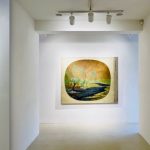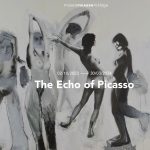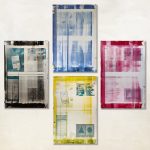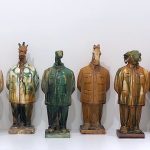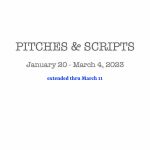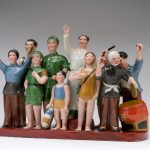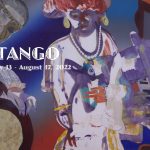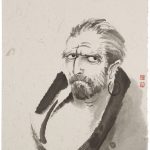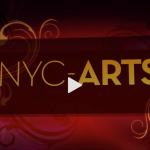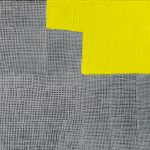By Megan Moser, The Mercury, Manhattan, Kansas, October 7th, 2018
Zhang Hongtu seemed genuinely excited to be in Manhattan on Wednesday.
The New York City-based artist and his wife, Miaoling, were in the Little Apple for the opening of his exhibition Culture Mixmaster, which is at K-State’s Beach Museum of Art through December. Zhang’s It’s his first solo show in the Midwest.
During a preview last week, Zhang, a youthful septuagenarian with white hair and trendy glasses, said he was thrilled with the way the exhibit had turned out.
“With this show, I didn’t come here to see the process of installation,” Zhang said, complimenting the museum’s curators. “It’s beyond my imagination. It’s still my work, but under a different concept of installation, lighting.”
Zhang’s work, like his life, is a blending of the East and the West.
Zhang grew up in China but has lived in America since the 1980s, so he’s now been in the U.S. as long as he had been in China. He likes to say he’s 100-percent Chinese and 100-percent American.
“When you see the show, you’ll see works that mix the tradition from Western European painting with classical Chinese painting,” curator Aileen June Wang said. “And all of his life, Hongtu has been thinking about this question and celebrating the richness of cultural exchange and cultural mixing.”
The pieces on display show a playful combination of influences and represent Zhang’s interest in the effects of travel and migration on culture.
The works include classic blue-and-white Chinese ceramics in the distinctive shape of Coke bottles, and a self-portrait that blends the styles of Pablo Picasso and Leonardo DaVinci’s “Mona Lisa.” That portrait was first made on the computer with Photoshop, and printed with an inkjet printer Wang said. Zhang later painted a version of it, so the printed version that’s on display at the Beach is actually the original, she said.
One entire gallery is devoted to a reimagining of Vincent Van Gogh’s 39 portraits as those of the Zen Bodhidharma.
Perhaps the most fun piece is an “interactive sculpture” called “Ping Pong Mao,” a table tennis table whose surface features cutout silhouettes of Chairman Mao Zedong.
On Saturday the museum staged a tournament using the table.
Zhang said the experience of playing on it — and trying to keep the ball from falling through the cutouts — is similar to the experience of living in China after the Cultural Revolution.
“The situation in China is still like this,” Zhang said. “You can criticize someone else, but not political leaders. So nothing changes, politically.”
He mentioned that his wife was a ping-pong champion at her school when she was a girl. Miaoling shook her head furiously, embarrassed by the attention.
Ping pong was an important tool in diplomatic relations between the United States in China in the 1970s. The use of the ping-pong table is another example of east-west culture exchange.
Zhang grew up in China as part of the Muslim minority. Because of his family’s religious and political beliefs, he said they suffered persecution under Mao, and he often felt like an outsider.
His family relocated many times between the Chinese Civil War and the beginning of the Cultural Revolution in 1966. At that time, he saw the political movement as edgy and was eager for change, so he supported it. He began to have doubts, though, when he saw the violence that arose from the revolution. He said he felt he had been fooled by someone he believed in.
He attended art school in China, where anything the students produced had to fit within the narrow scope of communist ideals, and there was a heavy emphasis on depicting Chairman Mao.
After college, Zhang continued to travel and immigrated to the United States in 1982 to find artistic freedom. His wife followed in 1984 with their son. Zhang and his wife now live in Woodside, Queens, a diverse neighborhood where Zhang told The New York Times “I’ve never felt like a foreigner.”
He got early attention for works like his 1989 “Last Banquet,” a version of “The Last Supper” that substitutes 13 Maos for Jesus and his disciples, a work that was part of a Guggenheim exhibit last year. Ironically, that piece was censored, though Zhang said.
Though he hasn’t lived in China for 30 years, Zhang said his view of China is still relevant today, as Mao’s influence persists. That said, he moved away from using Mao’s likeness in the 1990s.
Certainly the most attention-grabbing piece in the exhibition is the 45-by-12-foot “Great Wall with Gates III.”
Zhang made the first version of that work in 2009 for the anniversary of the fall of the Berlin Wall.
He made the current version especially for the Beach exhibit. It’s a digital image of the Great Wall of China altered with Photoshop to include a number of gates.
“I used the Great Wall not only about China, but basically about walls. Walls always divide, always stop people (from) going through,” he said. “I picked the image of the wall but with many many gates to change the function of the wall. Make it playful, not to block anymore.”
The exhibit’s title wall features a reproduction of a painting called Two Monkeys. Beach Museum curator Aileen June Wang said she asked Zhang whether the monkeys in the painting represented him, and he handed her a card that said, “You can ask me anything except about the monkeys,” she recalled, laughing.
But Wang said she and museum director Linda Duke have a theory. In Chinese literature there is a classic called “Journey to the West” about the adventures of a monkey god who accompanies a Chinese monk as he travels to India to get sutras and bring them back to China to contribute to the study of Buddhism.
“The journey of that monkey god is similar, or Hongtu feels some affinity, to the adventures of that character,” Wang said. Zhang smiled as she explained this but neither confirmed nor denied the hypothesis.
Artist talk by Zhang Hongtu
5 p.m. Tuesday
Zhang will share his experience of traveling to Dunhuang in western China, a town known as a hub of cultural exchange connecting Europe and Asia.
Related:
Categories: news
Tags: Zhang Hongtu
